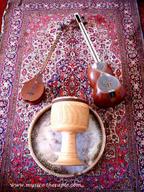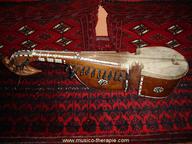|
|
Traditions Orales Les traditions orales de la musique |  On entend par tradition orale un ensemble d'héritage musical transmis de manière orale, ou comme le disent les orientaux, " de poitrine à poitrine". On entend par tradition orale un ensemble d'héritage musical transmis de manière orale, ou comme le disent les orientaux, " de poitrine à poitrine".
L'avantage d'une telle démarche dans l'apprentissage de la musique consiste à privilégier le canal auditif et d'entraîner ainsi la mémoire auditive, qui est très peu sollicitée lors d'un apprentissage et d'une pratique écrite de la musique.
De plus, qu'il s'agisse du point de vu émotionnel, relationnel ou simplement humain, cet approche permet un meilleur investissement sur le contenu sonore d'une tradition musicale.
Il est par ailleurs communément admis que l'apprentissage précoce du solfège peu induire rejet et désinvestissement émotionnel chez nombre d'enfants.
Le centre JAM, en intégrant les méthodes orales des musiques traditionnelles aux acquis de la psychologie et de la pédagogie moderne, propose des cycles de pratique et d'enseignement musical ouvert à tous.
Nous vous invitons à découvrir les différentes traditions qui sont enseignées dans notre centre, lors des portes ouvertes qui ont lieux le 1er lundi du mois: |
|  Tradition persane |  The persian music is certainly one of the oldest musical tradition which is transmitted in an oral way. Of share its use of the microtones (1/4 and 1/8 of tone), the practice of this tradition remarkably refines the capacities of the ear in the perception of the frequencies. The persian music is certainly one of the oldest musical tradition which is transmitted in an oral way. Of share its use of the microtones (1/4 and 1/8 of tone), the practice of this tradition remarkably refines the capacities of the ear in the perception of the frequencies.
- le tar
- le setar
- le kamancheh
- le santour
- le ney
- le robab
- le tombak
- le daf
|
|  Traditions indienne et afghane |  The practice of the Indian and Afghan musics allows a deepening of the rhythmic comprehension of the music. Rhythmic richness of these traditions, and the oral way in which they are taught allow the integration and the memorizing of long rhythmic sequences. The practice of the Indian and Afghan musics allows a deepening of the rhythmic comprehension of the music. Rhythmic richness of these traditions, and the oral way in which they are taught allow the integration and the memorizing of long rhythmic sequences.
- le tabla
- le zir-baghali
- le robab
- le tanbour
- le sitar
|
|
|  Tradition flamenca | | The song flamenco (flamenco lays) is an art created by the people gipsy and Andalusian, on the basis of popular folklore resulting from the various cultures which open out with the length of the centuries. In the beginning, flamenco consisted of a song without accompaniment (lays). Then the guitar seemed accompaniment (hat), followed hands (palmas) and dance (baile). The guitar and the dance are often only expressed from now on, although the song is always regarded as the c?ur of the tradition. More recently, of the instruments like the cajón (a percussion instrument coming from Peru), the palillos (castanets), and the low guitar, were introduced. |
|
|
| Copyright 2008. Shermin Movaffaghi,psychologue-musicotherapeute FAPSE ASMT | last update: Wednesday, April 05, 2017 |
|
|
|